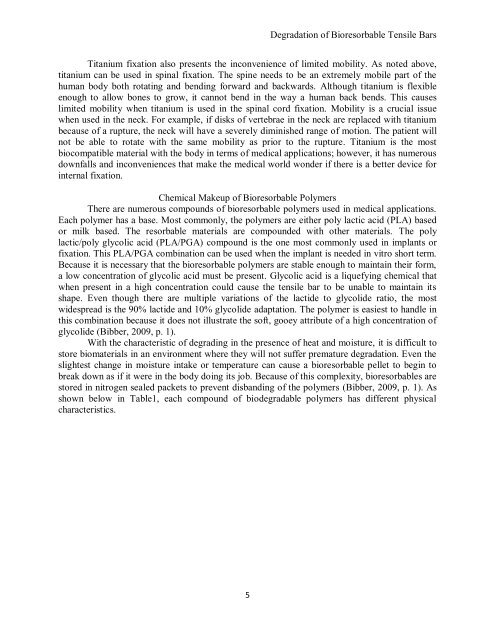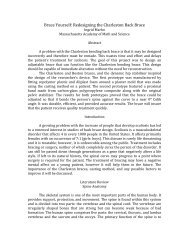A Study of Tensile Degradation of Bioresorbable Materials Used for ...
A Study of Tensile Degradation of Bioresorbable Materials Used for ...
A Study of Tensile Degradation of Bioresorbable Materials Used for ...
You also want an ePaper? Increase the reach of your titles
YUMPU automatically turns print PDFs into web optimized ePapers that Google loves.
<strong>Degradation</strong> <strong>of</strong> <strong>Bioresorbable</strong> <strong>Tensile</strong> Bars<br />
Titanium fixation also presents the inconvenience <strong>of</strong> limited mobility. As noted above,<br />
titanium can be used in spinal fixation. The spine needs to be an extremely mobile part <strong>of</strong> the<br />
human body both rotating and bending <strong>for</strong>ward and backwards. Although titanium is flexible<br />
enough to allow bones to grow, it cannot bend in the way a human back bends. This causes<br />
limited mobility when titanium is used in the spinal cord fixation. Mobility is a crucial issue<br />
when used in the neck. For example, if disks <strong>of</strong> vertebrae in the neck are replaced with titanium<br />
because <strong>of</strong> a rupture, the neck will have a severely diminished range <strong>of</strong> motion. The patient will<br />
not be able to rotate with the same mobility as prior to the rupture. Titanium is the most<br />
biocompatible material with the body in terms <strong>of</strong> medical applications; however, it has numerous<br />
downfalls and inconveniences that make the medical world wonder if there is a better device <strong>for</strong><br />
internal fixation.<br />
Chemical Makeup <strong>of</strong> <strong>Bioresorbable</strong> Polymers<br />
There are numerous compounds <strong>of</strong> bioresorbable polymers used in medical applications.<br />
Each polymer has a base. Most commonly, the polymers are either poly lactic acid (PLA) based<br />
or milk based. The resorbable materials are compounded with other materials. The poly<br />
lactic/poly glycolic acid (PLA/PGA) compound is the one most commonly used in implants or<br />
fixation. This PLA/PGA combination can be used when the implant is needed in vitro short term.<br />
Because it is necessary that the bioresorbable polymers are stable enough to maintain their <strong>for</strong>m,<br />
a low concentration <strong>of</strong> glycolic acid must be present. Glycolic acid is a liquefying chemical that<br />
when present in a high concentration could cause the tensile bar to be unable to maintain its<br />
shape. Even though there are multiple variations <strong>of</strong> the lactide to glycolide ratio, the most<br />
widespread is the 90% lactide and 10% glycolide adaptation. The polymer is easiest to handle in<br />
this combination because it does not illustrate the s<strong>of</strong>t, gooey attribute <strong>of</strong> a high concentration <strong>of</strong><br />
glycolide (Bibber, 2009, p. 1).<br />
With the characteristic <strong>of</strong> degrading in the presence <strong>of</strong> heat and moisture, it is difficult to<br />
store biomaterials in an environment where they will not suffer premature degradation. Even the<br />
slightest change in moisture intake or temperature can cause a bioresorbable pellet to begin to<br />
break down as if it were in the body doing its job. Because <strong>of</strong> this complexity, bioresorbables are<br />
stored in nitrogen sealed packets to prevent disbanding <strong>of</strong> the polymers (Bibber, 2009, p. 1). As<br />
shown below in Table1, each compound <strong>of</strong> biodegradable polymers has different physical<br />
characteristics.<br />
5
















